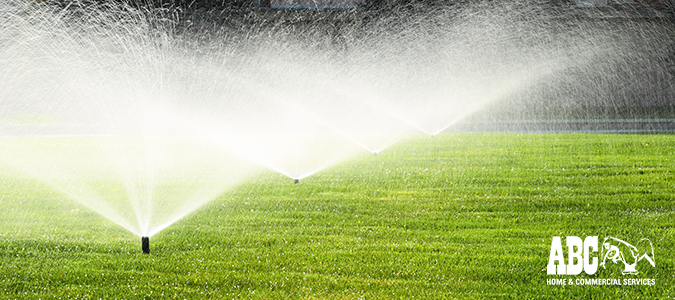
There are many ways to save water, but during the summer, the most effective water conservation improvements come from your sprinkler and irrigation system.
With just a little bit of knowledge, you can save water while keeping your landscaping healthy during hot, dry conditions.
Smart Irrigation Month Tips
-
Know how much water your lawn needs
The amount of water your lawn needs depends on a lot of different factors including climate, soil type and grass type.
The trick is to water deeply but infrequently. You get deep roots with deep watering. As a general rule of thumb, do not water more than 1-inch deep each time.
- Measure your sprinkler output by placing some tuna cans (or a similarly sized, flat-bottomed container) around your lawn.
- ¾ to 1 inch of water is a good amount each time you irrigate.
- You can get the average output by measuring the depth of water in each can and then dividing by the total number of cans.
- The sprinkler output will dictate how long you should be running the sprinklers.
Another test for knowing how much water your lawn needs is by pushing a long screwdriver into the soil one hour after watering. If it slides through easily, it has enough water.
-
Know when to water
So, now that you know how much to water, the next logical question is when, or how often, to water.
One quick way to test if your lawn needs water is by stepping on it. If you leave distinct footprints and the grass does not spring back, it’s time to water. As a general rule, water summer lawns every 3 days and winter lawns every 5 days.
-
Know where to water
When watering trees, look at the shape of the tree first. Different trees come in different shapes. Find the widest reaching branches and follow the line straight down to the ground.
The line around the edges of your tree’s canopy is known as the drip line. This is where you should water because it is where the roots are. If you are using drip irrigation, water around the drip line, not near the trunk or on the leaves.
Again, the best way to water trees is deeply but rarely. Larger trees will needs more water than smaller trees, and can also go longer without water.
According to Water Use It Wisely, the best way to know how deeply to water is the 1-2-3 Rule:
- 1 foot is the correct depth for small plants, such as groundcovers and annuals.
- 2 feet is the correct depth for shrubs.
- 3 feet is good for large shrubs and trees.
-
Know the right grasses and plants for your climate
It’s important to choose plants and grasses that are native to your area. If you are installing a lawn, speak with a professional lawn care expert about selecting a blend that can survive with little or no water for extended periods.
Plant a variety of native seasonal and perennials to suit your climate and taste:
- Consult a local lawn care expert to see which plants grow best in your environment.
- Pay attention to the plant care instructions. Be careful not to overwater or oversun plants.
- Use organic compost to help garden and vegetable crops absorb nutrients.
- Consider putting up a fence to prevent animals from trampling and eating garden plants. Learn more about controlling garden pests without pesticides.
- Speak with a local lawn care expert.
Low-Maintenance Plants for Dallas, Texas:
- Augustine grass
- Kurume azaleas
- Buxus microphylla japonica (Japanese boxwood)
- Quercus rubra (Red oak)
- Ophiopogon japonicus (Mondo grass)
- Herb garden
- Camellia sasanqua (White Dove)
- Ilex cornuta ‘Burfordii’ (Burford holly)
- Quercus virginiana (Southern live oak(
- Gelsemium sempervirens (Carolina jessamine(
- Liriope muscari ‘Silvery Sunproof’ (Big blue lily turf)
- Ajuga reptans (Carpet bugle)
- Raphiolepis indica (India hawthorn)
- Trachelospermum asiaticum (Asiatic star jasmine)
-
Consider a sprinkler or irrigation system
Your lawn will need more consistent watering in the spring and summer. In order to provide the right amount of water for your plants to survive the dry summer heat, it’s a good idea to set up a sprinkler or irrigation system.
The most efficient irrigation systems have either rain sensors or soil sensors. While soil sensors can detect the moisture of the soil at the level of roots, they are more complicated and expensive to install.
The best sprinkler and irrigation systems allow water to penetrate slowly to the root level without causing any water runoff. If your sprinkler system is causing water runoff, contact a professional to inspect the system.
In the summer, the best times to water your lawn are at night or in the cool early morning hours. This way, moisture can penetrate the roots instead of quickly being evaporated by the summer sun.
-
Plant new flowers, trees and plants
Spring is a great time to reassess and revive your lawn and garden:
- Make sure you seed new grass in early spring and fertilize before summer.
- Regularly mow and water your lawn. You may also benefit from aerating the lawn.
- Plant, roots, bacteria, fungi, and pests all interact and converse with each other. These chemical exchanges are essential for the growth and sustainability of your landscaping.
Additional Lawn Care Water Conservation Tips
- Always hire a professional to install and maintain your irrigation system. We recommend scheduling annual irrigation inspections to keep everything working properly and efficiently.
- Taller grasses are able to hold water better than shorter grasses. Set your lawn mower to a height of around 1.5 – 2 inches to retain more moisture.
- Leave grass clippings on the lawn to help keep the ground cool and retain moisture.
- Consider ditching the grass altogether and investing in xeriscaping, aka “dry-scaping.” It’s important to select a landscaping plan that matches your climate and property.
- Aerate your lawn every 6 months or so to make sure water is penetrating the roots instead of simply running off the surface.
- Allow your lawn to go brown during the winter.
- Since weeds compete with you grass and garden for water and nutrients, remember to weed regularly. Speak with the lawn care and pest control experts at ABC.
Sprinkler and Irrigation Repair
Indoor leaks are normally much more obvious than outdoor leaks. Periodically check your sprinkler and irrigation system for leaks, especially around the backflow device, irrigation valves, sprinkler heads and drip emitters.
While ABC Home & Commercial doesn’t install sprinkler and irrigation systems from scratch, we do perform sprinkler repairs and add-on work for existing systems.
Irrigation system repair work includes:
- Sprinkler heads
- Piping
- Timers
- Rain and Soil Sensors
- Water Leaks
At ABC Home & Commercial, we combine our pest control and lawn care expertise to give you the healthiest and most sustainable landscaping imaginable.
Any questions? ABC is happy to help. Contact us today!
